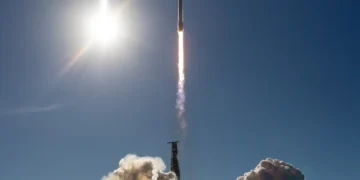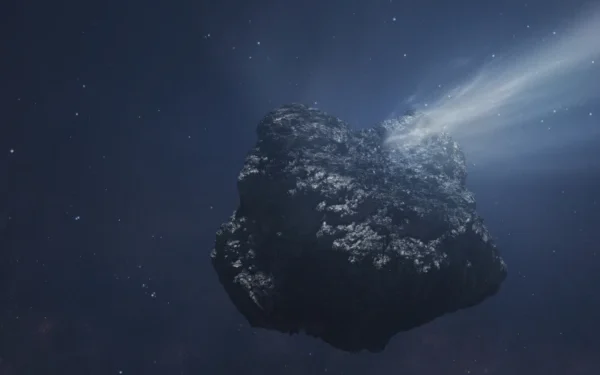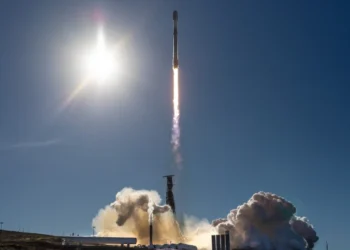Introduction: A Cosmic Time Traveler Enters Our Solar System
In a groundbreaking astronomical discovery, scientists have reported the arrival of a mysterious interstellar meteorite that may be 3 billion years older than our solar system. This extraordinary object, now officially named 3I ATLAS, entered our solar system earlier this month and has caught the attention of space scientists and cosmologists worldwide.
What makes this event particularly fascinating is the estimated age of the meteorite—approximately 7 billion years—which is significantly older than the 4.5 billion-year age of the solar system itself. If the findings are confirmed, this would make 3I ATLAS not only an interstellar visitor but possibly the oldest meteorite ever studied by scientists.
This marks only the third confirmed interstellar object to be observed within our solar system, following ʻOumuamua in 2017 and 2I/Borisov in 2019, reinforcing the idea that our solar neighborhood is not as isolated as once believed.
Understanding Meteorites and Their Origins
Meteorites are fragments of rock or metal that originate in space and survive their passage through Earth’s atmosphere to reach the surface. Most meteorites are derived from asteroids, comets, or planetary bodies within our own solar system. However, interstellar meteorites—those that originate from beyond the solar system—are incredibly rare and valuable for scientific study.
Interstellar meteorites offer a glimpse into the early conditions of other planetary systems, star-forming regions, and the chemical composition of the galaxy beyond our solar bubble.
Discovery of 3I ATLAS: How Was It Detected?
The newly discovered meteorite was detected by astronomers using the ATLAS (Asteroid Terrestrial-impact Last Alert System) survey, which is designed to monitor the sky for near-Earth objects and potential impact threats. The “3I” designation stands for “third interstellar” object, confirming its unusual trajectory and speed that could not be explained by gravitational interactions with the solar system’s planets.
The team at the University of Oxford, who led the study of the meteorite, conducted a thorough trajectory analysis, ruling out any solar system origin and concluding that the object came from far beyond the heliosphere—the boundary where the Sun’s solar wind ends and interstellar space begins.
Interstellar Origin: From the Galaxy’s Thick Disk
According to the Oxford researchers, 3I ATLAS originated from the “thick disk” of the Milky Way Galaxy, a region populated by older stars, some of which are over 10 billion years old. The thick disk is distinct from the thin disk, which contains relatively younger stars like our Sun.
This area of the galaxy is also known for its lower metallicity and higher vertical velocity, meaning the objects in this region move differently and more erratically compared to those in the thinner, denser galactic plane.
The meteorite’s origin in the thick disk suggests that it was likely formed in the early days of our galaxy, and may have traveled through space for billions of years before intersecting with our solar system.
How Scientists Estimated Its Age
The estimated age of 3I ATLAS—around 7 billion years—was calculated using cosmic-ray exposure dating, a technique that examines how long an object has been exposed to high-energy cosmic rays in space.
These rays, which are constantly bombarding celestial bodies that do not have an atmosphere or magnetic field for protection, leave distinct isotopic signatures. By measuring the concentrations of certain isotopes—such as helium-3, beryllium-10, and aluminum-26—scientists can determine how long a meteorite has been exposed to the interstellar environment.
In the case of 3I ATLAS, the measurements indicated exposure dating back billions of years prior to the formation of our own solar system, confirming its interstellar and ancient origin.
Comparison With Other Interstellar Visitors
1. ʻOumuamua (2017)
The first confirmed interstellar object, ʻOumuamua, was a highly elongated, cigar-shaped body that passed through the solar system in 2017. It had no visible tail, and its behavior sparked debates about its nature—ranging from comet, to asteroid, to even alien probe theories.
2. 2I/Borisov (2019)
This was the first interstellar comet, displaying a clear coma and tail. It was discovered by amateur astronomer Gennady Borisov and exhibited many characteristics similar to comets in our own solar system, although with a different chemical composition.
3. 3I ATLAS (2025)
Unlike its predecessors, 3I ATLAS is believed to be the oldest, with origins potentially tracing back to an ancient planetary system or even the remnants of a long-dead star. It offers an unprecedented opportunity to study pre-solar system material, helping scientists better understand how matter was distributed in the early galaxy.
Scientific Significance of 3I ATLAS
The discovery of 3I ATLAS is significant for several reasons:
- Windows into Galactic History: As a piece of matter older than the solar system, it holds clues to the conditions that existed in the early Milky Way.
- Understanding Planetary Formation: Studying the elemental and isotopic makeup of interstellar meteorites helps scientists refine models of how planets and stars form.
- Proof of Interstellar Exchange: These rare encounters demonstrate that objects can, and do, travel between star systems—raising intriguing possibilities about the interchange of organic molecules and possibly even precursors to life.
Could Interstellar Meteorites Contain Life or Its Precursors?
Although the notion may seem speculative, some scientists believe that complex organic molecules—and possibly even simple microbial life—could travel aboard interstellar objects. The theory of panspermia, which suggests that life may have been seeded across the universe through cosmic bodies like meteorites, gains subtle support from such discoveries.
While there is no evidence yet that 3I ATLAS contains organic compounds, its analysis may offer clues about the building blocks of life elsewhere in the universe.
What’s Next? Analyzing 3I ATLAS
Now that 3I ATLAS has been detected, researchers across the globe will aim to:
- Track its trajectory and study its physical characteristics
- Attempt spectroscopic analysis using ground-based and space telescopes
- Investigate chemical composition and mineralogy
- Propose sample return missions if technically feasible
Although capturing interstellar objects is extraordinarily difficult due to their high speeds and unpredictable paths, space agencies such as NASA and ESA are already exploring concepts for future interstellar interception missions.
Conclusion: A Messenger From the Stars
The arrival of 3I ATLAS is more than just a passing astronomical event—it is a message from the distant past, a reminder that our solar system is part of a dynamic and interconnected galaxy. As we continue to explore the cosmos, such discoveries enrich our understanding of the universe’s origins and the forces that shaped our planetary home.
With technology advancing and interest in space science growing, the study of interstellar visitors like 3I ATLAS may well hold the key to answering some of humanity’s most profound questions—about our place in the cosmos, the origin of life, and the mysteries of time and space.

























